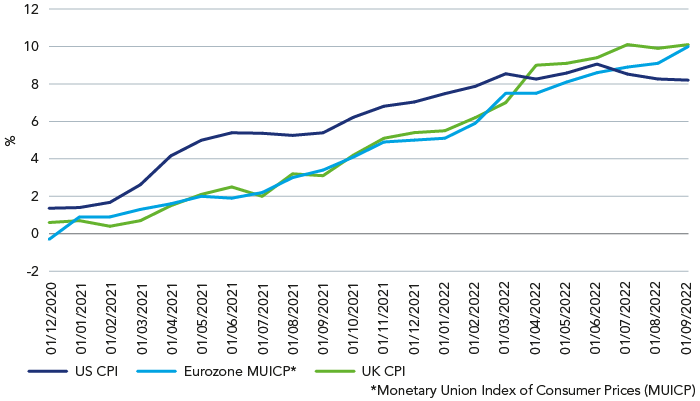- US consumer price index reached 8.2% in September, adding to pressure on the US Federal Reserve to tighten policy further.
- Markets unmoved by resignation of UK Prime Minister Liz Truss following days of speculation and appointment of new chancellor.
Amid high political drama in the UK, inflation continues to dominate investor concerns as data released this week showed the eurozone inflation rate hitting 9.9%1 and the UK’s 10.1%2 on the back of soaring food prices.
In the US, the consumer price index (CPI) rose to 8.2% in September, according to data released last week3. Stubbornly high consumer prices will add to pressure on the US Federal Reserve – which increased its policy rate by 75bps for the third consecutive time last month – to continue with aggressive monetary tightening.
Meanwhile, core CPI, which omits volatile energy and food costs, rose to 6.6% last month, faster than the 6.3% rate in August, suggesting that inflationary pressures were still accelerating.
“Last week’s US CPI surprised to the upside at 8.2% headline and 6.6% core, with one of the highest month-on-month changes in core CPI in recent years. It showed continued broadening in service sector inflation,” says Orla Garvey, Senior Fixed Income Portfolio Manager, Federated Hermes Limited.
Figure 1: Soaring inflation shows no sign of slowing

“The macro picture remains challenging, with inflation readings across the globe reinforcing the need for rate rises,” says Lewis Grant, Senior Portfolio Manager, Federated Hermes Limited.
In September, the European Central Bank raised its key benchmarks by an unprecedented 0.75bps to 1.25%4 while the Bank of England raised rates by 50bps to 2.25%. Further large increases are expected at in the coming weeks despite concerns about how much further central banks can continue to hike borrowing costs in the face of slowing growth.
UK political turmoil
The resignation of UK Prime Minister Liz Truss after a disastrous 45 days in office, the country’s shortest premiership, sent UK stocks fractionally higher on Thursday with the FTSE 100 closing up 0.3% while the pan-European Stoxx Europe 600 closed up 0.2%5.
The US blue-chip S&P 500 closed 0.7% lower on Wednesday after two days of solid gains following better-than-expected quarterly results by US banks.
“Earnings season began favourably, and early signs suggest that consumer demand may defy expectations, particularly at the luxury end,” Grant says, adding that forecasts that a warmer winter in Europe, easing pressure on natural gas prices, and suggestions that China may relax some Covid restrictions, provided further reasons for optimism.
“However, the initial wave of positive earnings releases has slowed and indicates potential weakness in industrial demand. US yields continue their upward momentum, with the dollar strengthening in tandem,” Grant adds.
The yield on the US 10-year treasury stood at 4.16% at 16:30 GMT on Thursday, 20 October, its highest level since 2008 amid concerns about a looming recession. The yield on the 10-year UK gilt, meanwhile, stood at 3.9% following the previous week’s gyrations6.
“The market has barely reacted to Liz Truss’s resignation so far and that’s because we will more than likely go back to a more orthodox fiscal stance, which has been priced in over the last few sessions following Jeremy Hunt’s appointment as chancellor,” Garvey says.
For further insights into global equites and supply chains please see Sustainable Global Equity, Q3 2022 report
1 Eurozone inflation at 9.9% in September (aa.com.tr)
2 UK inflation hits 40-year high of 10.1% | Financial Times (ft.com)
3 US consumer prices rise sharply despite Federal Reserve rate increases | Financial Times (ft.com)
4 ECB raises interest rates across eurozone by record margin | European Central Bank | The Guardian
5 & 6 Bloomberg as at 20 October







